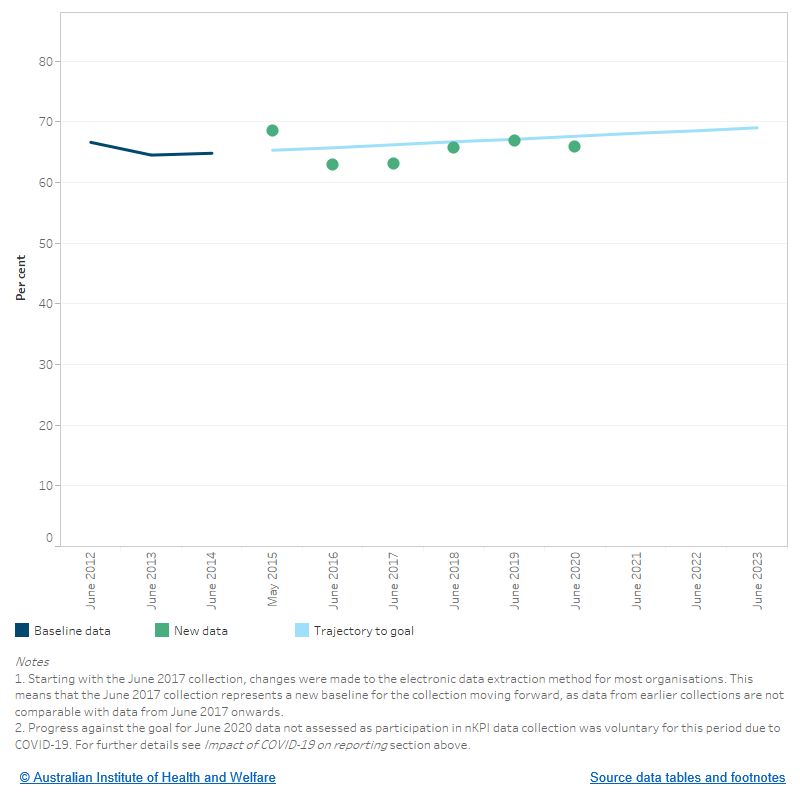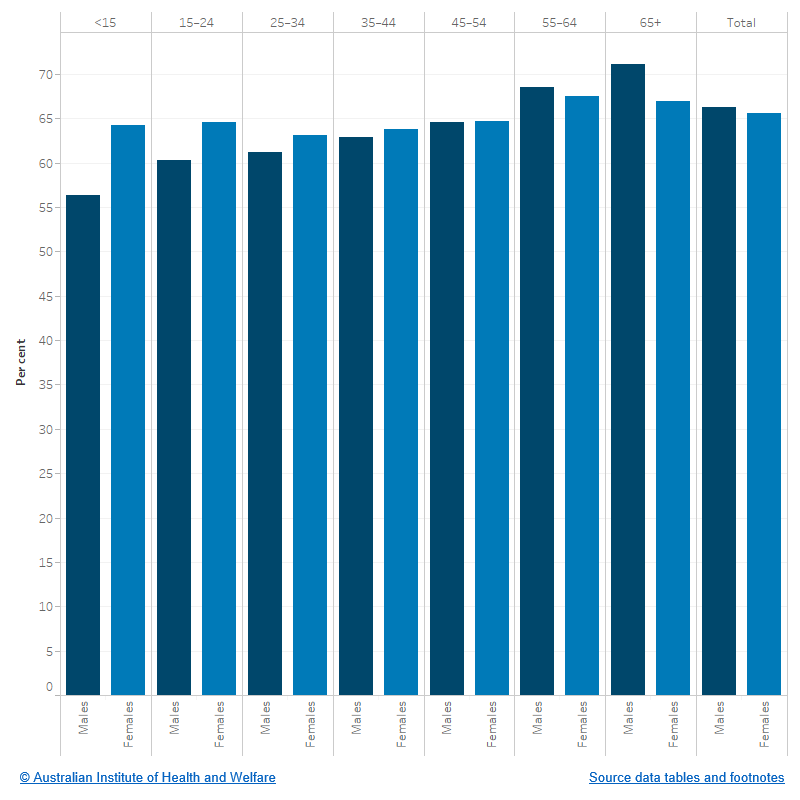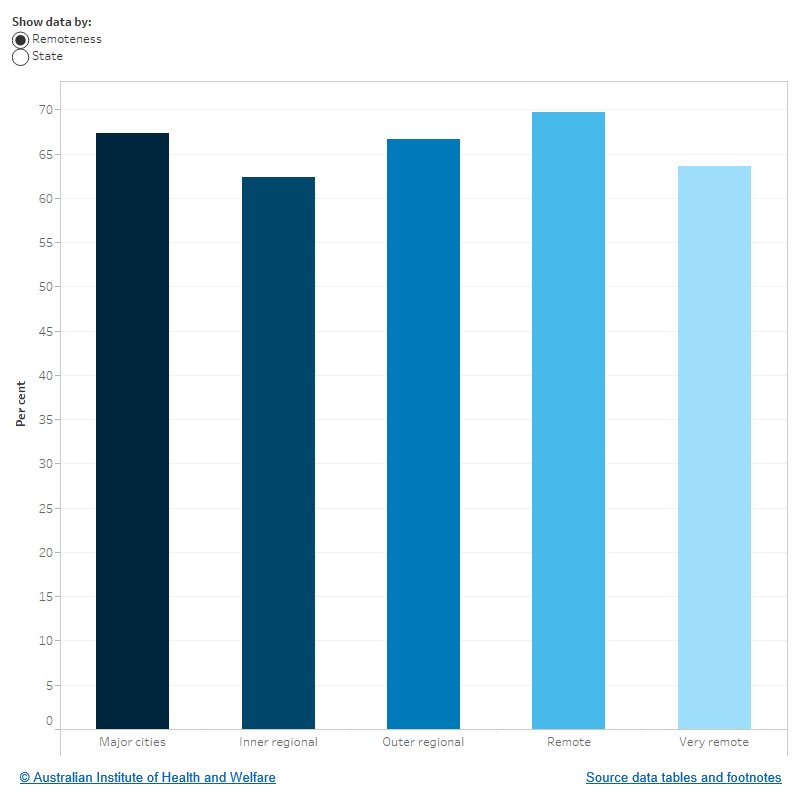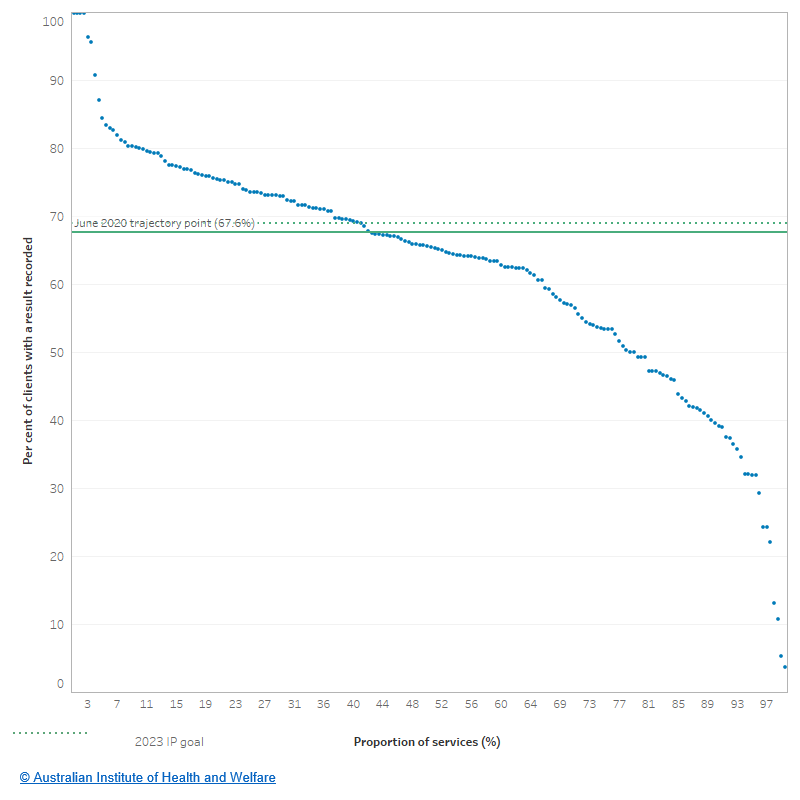Goal 16: HbA1c checks – people with type 2 diabetes
This indicator reports on the proportion of Aboriginal and Torres Strait Islander people with type 2 diabetes who had a regular glycosylated haemoglobin (HbA1c) test in the previous 12 months and are regular clients attending Indigenous specific primary health care services. The goal for this indicator is 69% by 2023.
Why is it important?
Chronic conditions, including diabetes, are the leading causes of illness, disability and death among Aboriginal and Torres Strait Islander people. Effective management and monitoring of diabetes, including regular HbA1c tests, can delay the progression of disease, improve quality of life and increase life expectancy.
What data are available?
In the absence of national data on Aboriginal and Torres Strait Islander people with type 2 diabetes who have regular glycosylated haemoglobin (HbA1c) tests, this indicator uses data from the Indigenous primary health care national Key Performance Indicators (nKPIs) data collection. These data pertain to Indigenous regular clients. A regular client is defined as a client who has attended the primary health care organisation at least 3 times in the last 2 years.
Impact of COVID-19 on reporting
In acknowledgement of the additional pressures on organisations because of COVID-19, reporting to the nKPI collection was temporarily changed from mandatory to voluntary in June 2020. This resulted in a decrease in the number of organisations that reported on Indigenous regular clients with type 2 diabetes who had a HbA1c result recorded in the previous 12 months from 209 in June 2019 to 194 in June 2020.
In addition, lockdown restrictions due to COVID-19 may also have impacted:
- The rates of delivery of clinical services
- The ability of clients to attend the services
- The way in which services were delivered (for example, greater use of telehealth).
What do the data show?
Progress towards the goal is not able to be assessed.
- The rate of Indigenous regular clients with type 2 diabetes who had their HbA1c result recorded within the previous 12 months in June 2020 was 66%, which was below the trajectory point of 68% required to meet the goal.
- The proportion increased from 63% in 2017 to 66% in 2020.
Nationally, in June 2020, among Aboriginal and Torres Strait Islander regular clients with type 2 diabetes:
- 66% had their HbA1c result recorded within the previous 12 months, which was below the trajectory point (68%) required to meet the goal for 2023.
- The proportion who had their HbA1c result recorded was lowest in the Northern Territory and South Australia (both 63%) and highest in Western Australia (71%).
Figure 16.4 shows the proportion of services by the percentage of regular clients with type 2 diabetes who had their HbA1c results recorded. For example, in June 2020, 42% of services had 67.6% or more of regular clients with type 2 diabetes who had their HbA1c result recorded within the previous 12 months.
Figure 16.1: Aboriginal and Torres Strait Islander regular clients with type 2 diabetes who had an HbA1c result recorded in the previous 12 months
The figure shows the baseline data, from June 2012 to June 2014, the trajectory towards the goal, from May 2015 to June 2023. New data show the proportion of Indigenous regular clients with type 2 diabetes who had an HbA1c result recorded in the previous 12 months from May 2015 to June 2020. Most recent data from June 2020 show that 65.9% of Indigenous clients had a result recorded in the previous 12 months.

Figure 16.2: Aboriginal and Torres Strait Islander regular clients with type 2 diabetes who had an HbA1c result recorded in the previous 12 months, by age group, June 2020
The figure shows that the rate of HbA1c results recorded among regular clients with type 2 diabetes generally increases with age. Differences by sex are most pronounced in the youngest and oldest age groups. Among those aged less than 15, females are more likely to have a result recorded (64.3%) than males (56.4%). Among those aged 65 and above, males are more likely to have results recorded (71.2%) than females (67.0%).

Figure 16.3: Aboriginal and Torres Strait Islander regular clients with type 2 diabetes who had an HbA1c result recorded in the previous 12 months, June 2020
The figure shows the rate of HbA1c results recorded among regular clients with type 2 diabetes by remoteness. Rates varied from 69.7% in Remote areas to 62.4% in Inner regional areas.

Figure 16.4: Organisations' results against the 2020 trajectory and 2023 goal for HbA1c result recorded, June 2020
The figure shows the proportion of services on the x-axis and the per cent of clients with a result recorded on the y axis. The graph shows that 41.8% of services had 67.8% or more of clients with a results recorded (the 2020 trajectory point).



